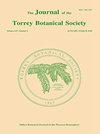艾伯塔省落基山脉前山脉沿海拔梯度分布对亚利桑那镁的控制
IF 0.8
4区 生物学
Q4 PLANT SCIENCES
引用次数: 4
摘要
产于北美洲和落基山脉北部,在由冷杉(Abies lasiocarpa)和云杉(Picea engelmannii)组成的亚高山树岛的林下最丰富。本种几乎完全通过顶片再生繁殖,其向低海拔地区的扩展可能分散有限。在海拔梯度上,实验采用了牛粪草作为根尖碎片和菌落移栽的方式进行分散。个体表现预计会与生境特征和竞争强度等随海拔变化的因素相互作用。通过详细的站点制图在站点水平上评估生境特征,并在研究区尺度上通过限制随机5 m半径样地评估生境特征。在海拔梯度上,研究了水杨花与锦绣绣花之间从竞争向促进的相互作用。实验设计包括6个高程等级,3个重复场地,每个场地内2个微型场地(云杉树基地和木绒地毯),每个场地有3个重复地块。在黄杨最丰富的地点,黄杨被排除在树密度较高的最小树岛之外。在研究区,黄花蓟马最可能生长在2000+ m枯枝落叶层较薄(< 3 cm)的树基周围,且同一树基上存在一种或多种其他苔藓植物。在两个生长阶段,云杉基地和水蛭地毯对柽柳生长性能的影响都比海拔的影响更明显。与云杉基部相比,水杉基部的成体移植物的原位有效量子产率较高,但顶端碎片的再生率较低。在云杉基部微站点中,中等海拔(1600-1800 m)的地块光照较多,且在片段再生、片段芽产生和成体移植物原位有效量子产方面不理想。在研究区,受这种优势的森林地面苔藓的竞争压力,在具有较深凋落物层的中等海拔的树基周围,黄毛霉向低海拔地点扩展活动范围的能力受到限制。本文章由计算机程序翻译,如有差异,请以英文原文为准。
Controls on the distribution of Mnium arizonicum along an elevation gradient in the Front Ranges of the Rocky Mountains, Alberta1
endemic to North America and in the northern Rocky Mountains it occurs most abundantly in the understory of subalpine tree islands formed by Abies lasiocarpa and Picea engelmannii. This species reproduces almost entirely through apical fragment regeneration and its expansion into lower elevation sites may be dispersal limited. Mnium arizonicum was experimentally dispersed along an elevation gradient as apical fragments and colony transplants. Individual performance was expected to interact with factors that vary with elevation such as habitat characteristics and competition intensity. Habitat characteristics were assessed at the site level by detailed site mapping and at the scale of the study area by restricted-random 5 m radius plots. The interaction between M. arizonicum and Hylocomium splendens was investigated for a switch from competition to facilitation along the elevation gradient. The experimental design included six elevation classes with three replicate sites and within each site two microsites (Picea tree base and Hylocomium carpet) each with three replicate plots. At sites where M. arizonicum was most abundant, it was excluded from the smallest tree islands with higher tree densities. In the region of the study area, the occurrence of M. arizonicum was most probable around tree bases located at 2000+ m with a thin (< 3 cm) litter layer and with one or more other bryophyte species present at the same tree base. The effects of microsite (Picea base versus Hylocomium carpet) on M. arizonicum performance were clearer in both life stages than the effects of elevation. Hylocomium microsites had consistently lower regeneration of apical fragments, but higher in situ effective quantum yield of adult transplants compared with Picea bases. Within the Picea base microsites, plots at intermediate elevations (1600-1800 m) received more light and were sub-optimal in terms of fragment regeneration, fragment sprout production, and in situ effective quantum yield of adult transplants. In the study area, the ability of M. arizonicum to extend its range into lower elevation sites was limited at intermediate elevations around tree bases that had deeper litter layers at intermediate elevation sites and in Hylocomium microsites by competitive pressure from this dominant forest floor moss.
求助全文
通过发布文献求助,成功后即可免费获取论文全文。
去求助
来源期刊
CiteScore
0.70
自引率
0.00%
发文量
16
审稿时长
>12 weeks
期刊介绍:
The Journal of the Torrey Botanical Society (until 1997 the Bulletin of the Torrey Botanical Club), the oldest botanical journal in the Americas, has as its primary goal the dissemination of scientific knowledge about plants (including thallopyhtes and fungi). It publishes basic research in all areas of plant biology, except horticulture, with an emphasis on research done in, and about plants of, the Western Hemisphere.

 求助内容:
求助内容: 应助结果提醒方式:
应助结果提醒方式:


